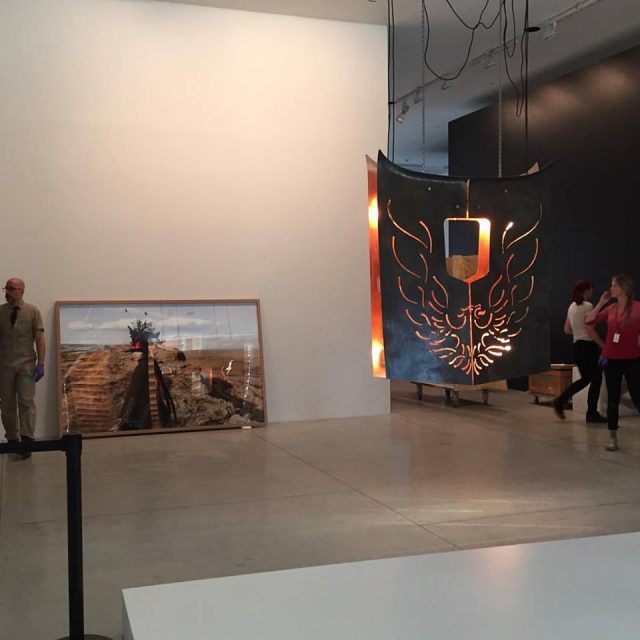Behind the scenes at Every. Now. Then.

Xiong Gu. Illuminated Niagara Falls, 2017. Digital photographs, fruit baskets, and souvenir water, dimensions variable. Photo courtesy of Andrew Hunter/Facebook.
This Wednesday night, AGO visitors are invited to take a first look at two of our three Canadian summer exhibitions—Every. Now. Then: Reframing Nationhood and Rita Letendre: Fire & Light; and a fresh look at Mark Lewis: Canada; Every. Now. Then. is the AGO’s response to the Canada 150 moment, featuring projects from artists across Canada that comment on Canada’s past, present and imagined future. At this moment of reflection in Canadian history, the exhibition attempts to fill in voices and stories that have traditionally been silenced or forgotten in mainstream society.
There’s every kind of art you can imagine in Every. Now. Then.—from photography to paintings and illustrations to large-scale installations to video and textiles. There’s even a mini-replica of a fictional Canadian town called Dominion (created by the cartoonist, Seth). For Andrew Hunter, the AGO’s Fredrik S. Eaton Curator, Canadian Art, the challenge is finding a layout for all of these different pieces that makes sense thematically, artistically and conceptually for the visitor.
We asked Andrew a few questions about the installation process of Every. Now. Then.
AGO: How are you approaching the layout of this exhibition differently, as opposed to previous projects on Level 4?
Andrew: I’ve never done a project on Level 4 of the AGO’s Contemporary Tower] before, but we tried to follow the lead of Toronto: Tributes + Tributaries in the approach. It’s very different from the Sam & Ayala Zacks Pavilion (where most touring exhibitions are located, and where Georgia O’Keeffe is currently being shown) as you have to work with existing structures and there isn’t a clear pathway through the galleries and spaces. The positive aspect is the openness of Level 4 encourages a less linear approach, which I really like. And it encourages visitors to make their own path.
AGO: What can visitors expect to see on the wall panels?
Andrew: There are no wall panels this time. Instead, there are lots of quotes from the artists, translated into Anishinaabemowin and English.
AGO: Do you have any advice on how to explore the gallery?
Andrew: There is no set linear approach, so you can move through the exhibition any way you wish. I do encourage people to follow their own path and retrace their steps as there are many connections across works and spaces.
AGO: What are you excited for people to see up close?
Andrew: Everything! There is a great shift in the scale of works in this show, from huge installations and projections to tiny intimate objects. My hope is that we have created an exhibition that visitors will spend a lot of time in, and that this will feel like a very timely and progressive project with lots of ideas and questions to absorb.
Every. Now. Then: Reframing Nationhood is free with the price of admission. Members of the AGO can see it for free—find out more about becoming a Member now.
Are you an AGOinsider yet? If not, sign up to have stories like these delivered straight to your inbox every week.
Every. Now. Then: Reframing Nationhood Supporters:

